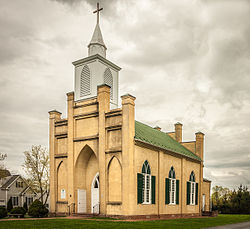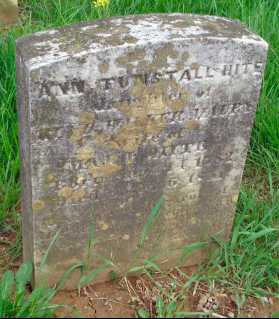Mrs. Hite […] is one of the sweetest little women I know, very sensible and agreeable.
Nancy Carr, a resident of Winchester, Virginia, writing to her cousin, Elizabeth Coalter, on April 24, 1822
Ann Tunstall Maury was the daughter of Reverend Walker Maury and Mary Stith Grymes, born on September 14, 1782 on Halifarm, a family property in Orange County, Virginia. Her parents were influential in political and religious arenas in the Tidewater region of Virginia.
In 1786, when Ann was only 4-years-old, she moved with her family to Norfolk when her father accepted a job as master of Norfolk Academy, a private boy’s school, and minister at Old Saint Paul’s Church. Her father died just two years later, in 1788, from yellow fever at just 36-years-old.
After Reverend Maury passed away, Ann’s mom, Mrs. Grymes, was left to take care of their eight children, including a newborn. Once she settled her husband’s estate, Mrs. Grymes was left with just £25, not much to raise her family, so she started an all-girls school in Orange County, Virginia and mortgaged out her enslaved people for extra income.
DID YOU KNOW?
Mrs. Grymes mortgaged out an enslaved mother, Sukey, and her daughter, Milly, in 1796 for £70and then just Milly for £40 once again in 1798. The term “mortgage” in this context means to use enslaved people as collateral instead of paying cash up front for things like property and more enslaved people.
Marriage
We don’t know much about when or how Ann and Isaac met as adults, but the story goes that Ann attended Isaac and Nelly’s wedding in 1783 when she was just a baby. Her father, Reverend Walker, teased that Isaac may have Ann for a second wife, which is precisely what he did! After the death of his first wife, Nelly Madison, Isaac frequently visited his former in-laws, James and Eleanor Madison, at Montpelier, which wasn’t far from Halifarm, Ann’s homestead, so it’s likely that the two met during one or more of Isaac’s visits.
The two wed on December 1, 1803, likely at Halifarm. The document below is a transcription of the marriage settlement of Isaac Hite and Ann Tunstall Maury.
A Mother can never divest herself of anxiety in some way or another; her happiness is completely united with that of her offspring that she must literally weep or rejoice with them.
Mrs. Hite, 5 July 1827
Motherhood
Upon her marriage, Mrs. Hite was not only a new bride but also a new stepmother to Isaac and Nelly’s two children, 14-year-old Nelly and 10-year-old Madison. Between 1805 and 1819, she bore ten healthy children, all of whom survived to adulthood, which was an unbelievable feat at the time:
- Ann Maury Hite: 1805-1833
- Isaac Fontaine Hite: 1807-1884
- Mary Eltinge Hite: 1808-1856
- Rebecca Grymes Hite: 1810-1851
- Walker Maury Hite: 1811-1890
- Sarah Clark Hite: 1812-1896
- Penelope Elizabeth Lee Hite: 1814-1838
- Hugh Holmes Hite: 1816-1870
- Cornelius Baldwin Hite: 1818-1841
- Matilda Madison Hite: 1819-1853
Nothing can equal the happiness of a parent blessed with the society of virtuous children all living in love and harmony.
Mrs. Hite on 20 June 1825
Mrs. Hite’s letters provide more insight on being the matriarch in her large family.
Widowhood
After Major Hite died on November 24, 1836, their property – from the mills, to the stables – were run by the couple’s eldest son, Isaac Fontaine Hite. Within a few years of each other, Ann also lost her mother; her grown stepdaughter, Nelly Hite Baldwin; her eldest daughter, Ann Williams; and another one of her daughters, Penelope Green.
After enduring such loss in a relatively short period of time, coupled with her advancing age, Mrs. Hite spent her days with family that lived nearby and engaged in hobbies like quilting and painting.
Mistress
In addition to being a mother and stepmother, Mrs. Hite was Belle Grove Plantation’s mistress, meaning that she supervised all household activities, such as planning meals, overseeing the enslaved labor in the kitchen, sewing, dying wool, making candles, tending to the sick (in her family as well as the enslaved families), and coordinating her children’s education.
I must lay down by my pen as I am wanted to weigh wool.
Mrs. Hite on 13 June 1822
I have been so much engaged in nursing the sick the greater part of the fall and winter that I have had but little time to write to my absent friends, for the last three of four weeks. My mother has been confined to her bed not able either to walk or turn herself. My presence is always required in her room day and night.
Mrs. Hite on 9 May 1838

Religion
Mrs. Hite’s roots are rich and deep in influential religious leaders from the Tidewater region in Virginia. She herself was a part of the revival of the Episcopal Church in Virginia during the 1820s and 1830s, and Bishop William Meade, a notable local religious leader, played a crucial role in this revival.
Episcopalians in Middletown, including Mrs. Hite, raised money to build St. Thomas Episcopal Church, which was fully built by 1837. Bishop Meade noted in his personal journal, “On the 28th (September) I preached at Middletown, and baptised an infant…here is about to be completed the seventh Episcopal Church in what was formerly Frederick County.“
Our new church in Middletown was finished and the Bishop consecrated it the 25th of August we had 4 ministers with the Bishop. The meeting lasted 3days. I wish you and cousin Caroline could have been with us. We had excellent preaching, a very large and attentive congregation and I trust its influence will yet ‘bring forth fruits meet for the kingdom of heaven.’
Mrs. Hite telling Elizabeth Steenbergen about St. Thomas Episcopal Church on 6 September 1837
Mrs. Hite’s faith was front and center in her life, which is evident in her letters.
What do you think?
Do you think that Mrs. Hite’s religious beliefs affected her perspective on the people she enslaved or on enslavement in general? Make sure to investigate Mrs. Hite’s beliefs on enslavement here.

The hand of death […] is a warning to us all my dear child to be prepared for that event for come it must and we should endeavor to meet the summons with fortitude and resignation whether it be for ourselves or our friends.
Mrs. Hite writing to her daughter, Ann Maury, on 30 June 1826